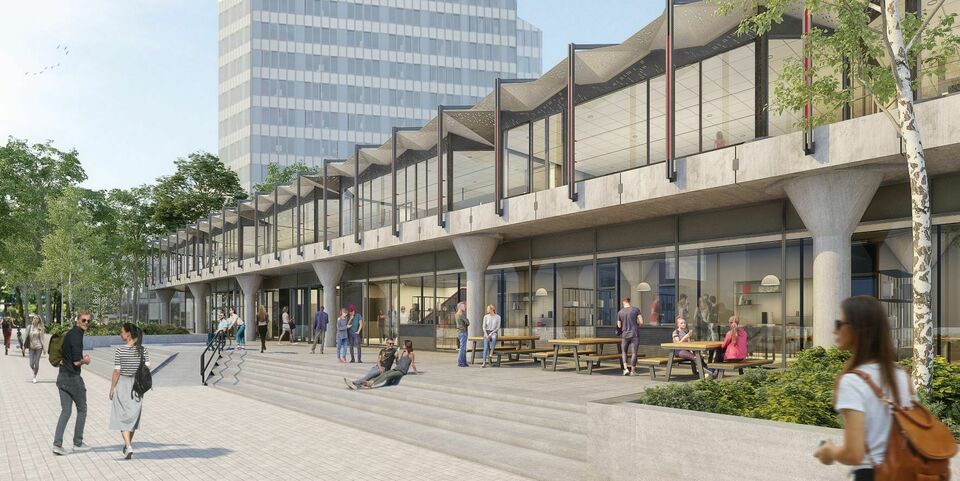Neuron open in February, plus update construction projects
Real Estate expects that the Neuron building at the Laplaceplein will be ready for use in February of next year. This means that AI institute EAISI will have its own room and that the number of teaching rooms increases significantly. A new challenge lies in finding a suitable location for the construction of a new cleanroom, which will be located in the direct vicinity of Flux.
The construction activities currently taking place on the TU/e terrain are impacted by more or less the same problems as those facing the Dutch construction sector as a whole. In practice, this has led to a material and labor shortage.
As a result, the completion of Neuron (the former Laplace building, the last occupant of which was the department of Industrial Design) suffered a four-month delay, according to Jan-Willem Schellekens, head of Real Estate’s project bureau. Schellekens: “It’s a big challenge, but as of the third quartile, TU/e will have a beautiful new facility, thanks to the efforts of a lot of people.”
Extra teaching room
The Eindhoven Artificial Intelligence Systems Institute (EAISI) is one of the occupants of the new building, which will also provide students and staff members with several new teaching facilities, including twenty DBL rooms, fifteen lecture halls, and five hundred study places for students. Schellekens points out that the walkway in the direction of the adjacent Traverse building will also open again. “A part of Traverse is currently being used by the departments of Mechanical Engineering (ME) and Biomedical Engineering (BmE), but we’ve already created forty DBL rooms there at this point.”
As of yet, there are no plans for a renovation of Traverse similar to the one that Neuron has underwent, Schellekens says. “We did however install a new ventilation system, among other things, in Traverse last year, during the relocation of ME and the realization of the DBL rooms.”
Continue reading under the illustration.
Asbestos removal
The extensive renovation of Gemini, the official home of ME and BmE, started last year and is proceeding according to plan, Schellekens says. “We do however need to once again apply explicit safety measures during demolition activities when we remove asbestos from this building. But these measures applied to every on-campus building we’ve renovated over the years. Fortunately, we were able run the development of the technical design in parallel to these activities.”
The renovation of Gemini takes place in two phases, starting with Gemini-Noord, which currently houses many of the labs of ME, followed by Gemini-Zuid, the current location of, among other occupants, BmE. Schellekens: “The labs that used to be located at Gemini-Noord will return to that location, but that part of the building will also include five new lecture halls and sixteen DBL rooms.” The completion of Gemini-Noord is scheduled for 2024. The expected completion date for the entire renovation project is 2027, the head of the project bureau says.
Cleanroom
At this point, Real Estate is facing a new challenge: finding a construction location in the direct vicinity of Flux, which houses Electrical Engineering and Applied Physics & Science Education. The main function of this new building is to accommodate the university’s new cleanroom.
The old cleanroom, which is located behind Flux in the Spectrum building, has been operating 24 hours a day seven days a week for the past twenty years and needs to be replaced, Schllekens says. “We have been carrying out a number of (technical) preliminary investigations for some time now. One of the important decisions we need to make concerns the proper location, taking into account, among other things, our network of walkways and the vibration sensitivity of the location that we’ll eventually settle on.” It has by no means been decided that the new cleanroom will be located on the parking space of Flux, as Cursor was told. “We are looking into several options.”
Wide slab floors
The current cleanroom made thenews a few years back because the wide slab floors in Spectrum resembled those used in the parking garage at Eindhoven Airport, which partially collapsed before it was put to use. Schellekens says that the floors in Spectrum are monitored every two months, in accordance with standard practice with specialist in this field from the Eindhoiven municipality, and that no abnormalities were found.
“During the future renovation of Spectrum, we will immediately take the most appropriate measures based on the latest scientific insights,” Schellekens says, “and we will coordinate this with our Built Environment department.”
The university will not exceed the fixed housing ratio of fourteen percent – the percentage of the total budget it is allowed to spend annually on housing – with the realization of the current construction projects, Schellekens says in conclusion.



Discussion